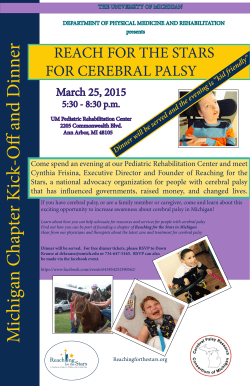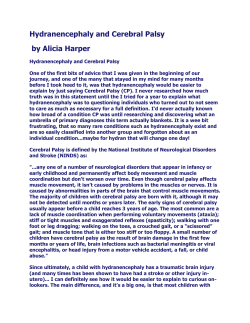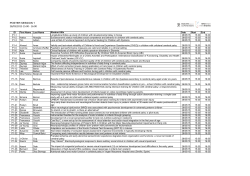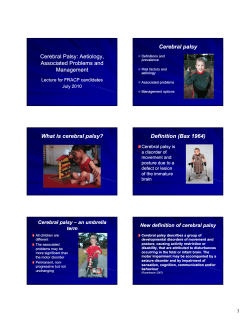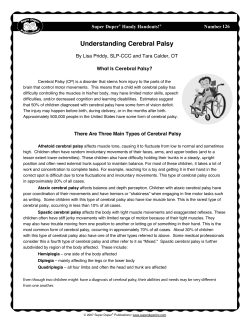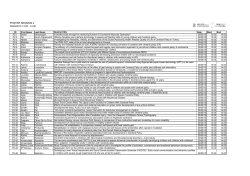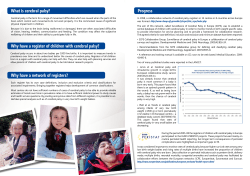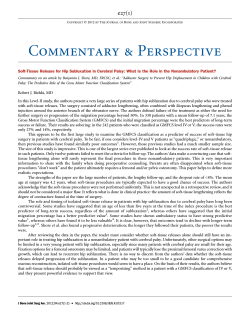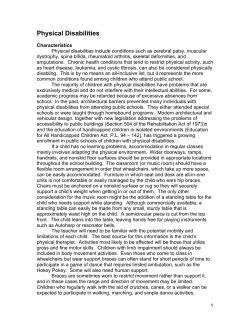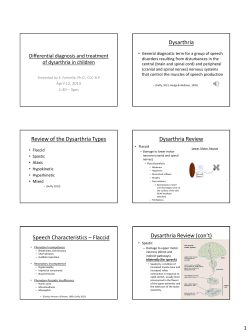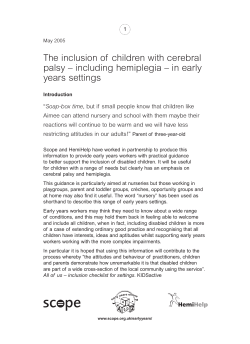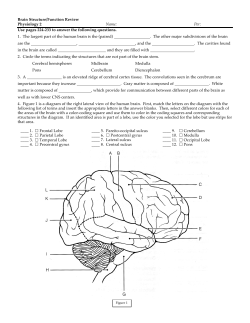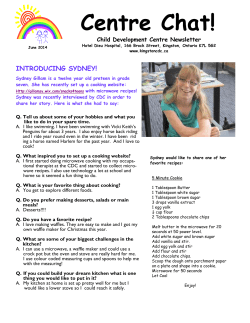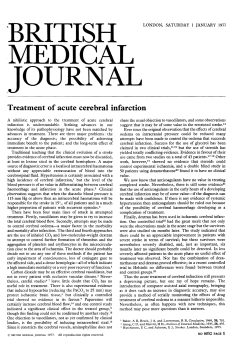
Cerebral Palsy
Cerebral Palsy Introduction Cerebral palsy, or CP, can cause serious neurological symptoms in children. Up to 5000 children in the United States are diagnosed with cerebral palsy every year. This reference summary explains CP and its treatment options. Anatomy The brain is the command center of the body. It controls all 5 of our senses as well as our ability to speak and move. The right side of the brain controls the left side of the body. The left side of the brain controls the right side of the body. In order to function, the brain needs a continuous supply of oxygen. The oxygen is carried in the blood to the brain. The heart pumps blood continuously. The brain may undergo irreversible damage if it does not get enough oxygen or blood. Cerebral Palsy Cerebral palsy is the name given to a group of disorders that affect a child’s control of movement. These disorders appear in the first few years of life. CP is caused by problems with the motor skill areas of the brain. These areas may develop abnormally or get damaged. The brain's ability to control movement and posture is disrupted. Even though the brain damage that causes cerebral palsy does not usually get worse over time, patients can have worsening of their symptoms. The muscles can get tighter leading to more joint deformities. This can lead to increased pain. Fine motor skills can also get worse, as well as bladder and bowel control. Difficulties in breathing can also show up. This document is for informational purposes and is not intended to be a substitute for the advice of a doctor or healthcare professional or a recommendation for any particular treatment plan. Like any printed material, it may become out of date over time. It is important that you rely on the advice of a doctor or a healthcare professional for your specific condition. ©1995-2011, The Patient Education Institute, Inc. www.X-Plain.com Last reviewed: 06/21/2011 nr200104 1 People used to think that CP was due to injury during birth. Now we know that CP can occur before birth, during birth, or in the first few months of life. Symptoms & Complications Symptoms of cerebral palsy include: • difficulty with fine motor tasks such as writing or using scissors • difficulty maintaining balance or walking • weakness in an arm or a leg or a combination of both • involuntary movement • excessive drooling when it affects the muscles of the face Early signs of cerebral palsy usually appear before 3 years of age. Infants with CP are often slow to reach developmental milestones such as learning to roll over, sit, crawl, smile, or walk. Symptoms differ from person to person. They may be very mild and barely noticeable or very severe, causing the patient to be bed-bound. Some people with cerebral palsy are affected by other medical disorders including seizures or mental impairment. However, cerebral palsy does not always cause severe handicaps. CP can cause muscles to become very tight or spastic, causing contractures. A contracture is severe muscle tone that makes it impossible for a joint to move. This can lead to abnormalities in joints. CP can cause muscles to have no tone at all, making them limp and floppy. This can lead to joints dislocating because the muscles do not help stabilize them. For children who have problems swallowing, getting the right nutrients can be a problem and may require the help of nutritionists. Some medical conditions that sometimes accompany CP can make health conditions worse for patients. These include: • seizures • mental retardation • problems with vision, hearing, and speech This document is for informational purposes and is not intended to be a substitute for the advice of a doctor or healthcare professional or a recommendation for any particular treatment plan. Like any printed material, it may become out of date over time. It is important that you rely on the advice of a doctor or a healthcare professional for your specific condition. ©1995-2011, The Patient Education Institute, Inc. www.X-Plain.com Last reviewed: 06/21/2011 nr200104 2 Causes & Risk Factors Meningitis, or infection of the coverings of the brain and spinal cord, has been linked to CP. Abnormal brain development, whether inherited or due to injuries while in the womb, can result in CP. Such injuries may involve lack of blood flow to areas of the brain or bleeding inside the brain. If a mother gets certain infections during pregnancy, CP can also result. Such infections include rubella (German measles). CP can also result when a baby’s blood type is different than its mother’s blood type. Some of the baby’s red blood cells may be destroyed, causing high levels of a special chemical called bilirubin. Bilirubin causes skin to turn yellowish, a condition called jaundice. An increase in bilirubin can also cause brain damage and CP. Severe head injury in the first few months of life has been associated with cerebral palsy. In addition to the many possible causes of CP that are known, there are still many cases of CP that have no known cause. Doctors have identified some other risk factors associated with CP. This does not mean that patients at risk will get CP; it only means that they have a risk of developing it. People at higher risk of developing CP include • babies who are born prematurely or with a low birth weight. The smaller the baby, the higher the chances are that CP will develop. • babies of mothers who had vaginal bleeding during pregnancy • babies of mothers who had very difficult labor, especially breech births. Breech means that the baby is not in the usual headfirst position as it enters the birth canal. • babies who had meconium staining. Meconium staining is when the baby passes stools while still in the uterus. Diagnosis Doctors diagnose cerebral palsy by testing motor skills and reflexes, looking into medical history, and using specialized tests. This document is for informational purposes and is not intended to be a substitute for the advice of a doctor or healthcare professional or a recommendation for any particular treatment plan. Like any printed material, it may become out of date over time. It is important that you rely on the advice of a doctor or a healthcare professional for your specific condition. ©1995-2011, The Patient Education Institute, Inc. www.X-Plain.com Last reviewed: 06/21/2011 nr200104 3 CAT scans or MRI’s may be done in order to look more closely at the brain and rule out other possible causes of symptoms. Other health conditions can have symptoms that are similar to the symptoms of CP including brain tumors, water on the brain, and bleeding in the brain. Prevention & Treatment Currently there is no cure for CP. The brain damage that leads to CP is not curable.It is best to prevent cerebral palsy rather than try to treat it. Good prenatal care helps decrease the risk of CP by preventing premature births, low-birth weight, and infections affecting the mother. It is very important for women to have rubella vaccinations before becoming pregnant. CP treatment focuses on making the best of the situation through therapy, drugs, surgery, and mechanical aides. Physical therapy helps strengthen muscles, improves walking and keeps joints from forming contractures. Occupational therapy teaches children how to perform daily tasks such as throwing balls, feeding, and dressing themselves. Speech therapy helps improve speech, understanding, and swallowing. Drugs are used to control seizures and muscle spasms. Braces can compensate for muscle imbalance. Surgery and mechanical aids can help to overcome impairments. These include orthopedic surgeries to adjust tendons or fuse joints. For patients with severe tightness of the leg muscles, a pump can be surgically implanted to deliver a relaxing medication, baclofen, to the nerves in the spine. Another spine operation that consists in cutting some nerves in the spinal canal to relieve spasticity may be necessary. It is known as selective dorsal root rhizotomy. Hearing aids can help improve hearing. Eyeglasses or eye surgery can correct visual problems. Counseling for emotional and psychological needs, and behavioral therapy may be employed. Educational aid may help children reach their full academic potential. This document is for informational purposes and is not intended to be a substitute for the advice of a doctor or healthcare professional or a recommendation for any particular treatment plan. Like any printed material, it may become out of date over time. It is important that you rely on the advice of a doctor or a healthcare professional for your specific condition. ©1995-2011, The Patient Education Institute, Inc. www.X-Plain.com Last reviewed: 06/21/2011 nr200104 4 The parents and family of CP patients may have feelings of grief, sadness, and guilt. These feelings should be discussed with a specialist. Support groups are available to help CP patients cope with their situation. Summary Since there is no cure for cerebral palsy, prevention is essential. Having good prenatal care under the supervision of a doctor is the best way to prevent CP. Thanks to current advances in medicine, as well as laws created to help the disabled, the lives of people with CP are easier and more productive than before. Most patients with mild to moderate CP are able to lead very fruitful lives and enjoy a wide range of physical and intellectual activities! This document is for informational purposes and is not intended to be a substitute for the advice of a doctor or healthcare professional or a recommendation for any particular treatment plan. Like any printed material, it may become out of date over time. It is important that you rely on the advice of a doctor or a healthcare professional for your specific condition. ©1995-2011, The Patient Education Institute, Inc. www.X-Plain.com Last reviewed: 06/21/2011 nr200104 5
© Copyright 2025
